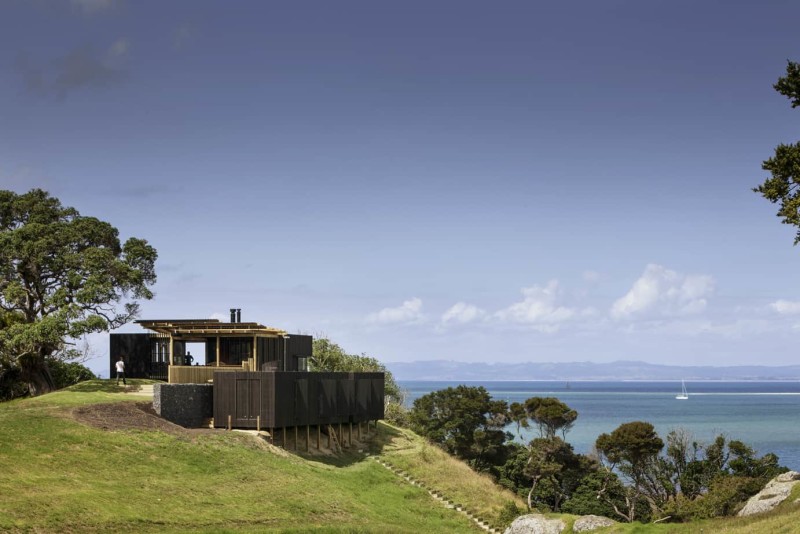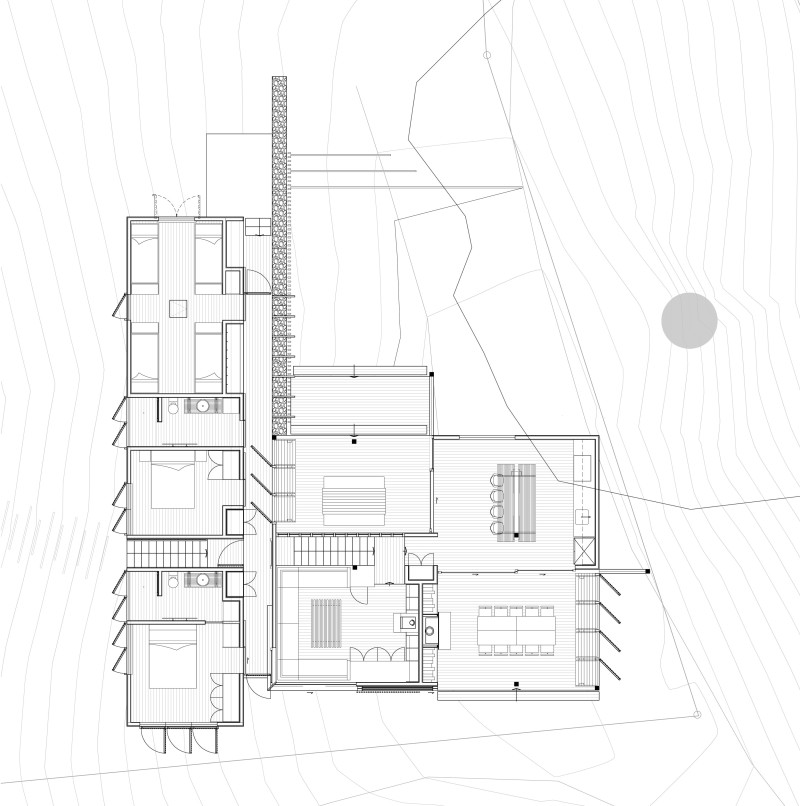
The Site:
Whangarei Heads, New Zealand
The site on which this home was designed was a large, cranked and hilly site with the prescribed building platform positioned on the crest of the seaside knoll.
 Its views consisted of a South facing sea view and a North facing mountain view.
Its views consisted of a South facing sea view and a North facing mountain view.
The site featured – a mature New Zealand native Pohutukawa tree which stood on the knoll.
A watercourse and associated wet gully runs along the Eastern boundary accented by a large boulder.
The knoll drops off sharply to a crescent shaped bay fringed with mature trees.
The Constraints:
The building platform on the knoll has an 8m rolling height limit.

The Brief:
The client’s wanted a holiday house for primarily summer use with a boatshed type garage. They did not wish to use the house as a permanent residence.

The Concept:
This building is a continuation of our exploration in a genre of building that is specifically designed for occupation in the summer months. In the design process we attempt to challenge the boundaries between the built form and nature to heighten the experience of immersion in nature.
 We challenge also the accepted levels of comfort and utility for the same reason. We attempt also to reference the nostalgia surrounding the “Kiwi bach” by manipulating scale, form, relationships, materiality and limitation of amenity.
We challenge also the accepted levels of comfort and utility for the same reason. We attempt also to reference the nostalgia surrounding the “Kiwi bach” by manipulating scale, form, relationships, materiality and limitation of amenity.
 Our Response:
Our Response:
We decided to break the building into 2 primary components in order to reduce the scale and to allow the bach to follow the contour of the land.
 We created a single cut in the knoll and retained it with a gabion wall, this set up a spine around which the components can be ordered.
We created a single cut in the knoll and retained it with a gabion wall, this set up a spine around which the components can be ordered.
 Separating the functions by a full level allowed a panoramic view from the living level and to step the house down towards the beach.
Separating the functions by a full level allowed a panoramic view from the living level and to step the house down towards the beach.
 The living pavilion is articulated as a series of 4 spaces in a pinwheel arrangement; a kitchen, a lounge and 2 covered decks. The kitchen aspects towards both the north and south deck depending on the prevailing wind conditions by manipulating a series of doors and shutters.
The living pavilion is articulated as a series of 4 spaces in a pinwheel arrangement; a kitchen, a lounge and 2 covered decks. The kitchen aspects towards both the north and south deck depending on the prevailing wind conditions by manipulating a series of doors and shutters.
 A stair drops to the lower level and penetrates the gabion wall, a covered outside walkway running along the gabion wall connects to the bedroom spaces.
A stair drops to the lower level and penetrates the gabion wall, a covered outside walkway running along the gabion wall connects to the bedroom spaces.
 The stair continues on axis with a powerful rock formation at the base of the slope to make the connection to the beach. A black stained rainscreen cladding introduces a crenelated layering which peels open in part to allow views and privacy or wind screening.
The stair continues on axis with a powerful rock formation at the base of the slope to make the connection to the beach. A black stained rainscreen cladding introduces a crenelated layering which peels open in part to allow views and privacy or wind screening.
 Structural timbers are generally exposed and left without color embellishment.
Structural timbers are generally exposed and left without color embellishment.
HERBST ARCHITECTS LTD Ph 09 377 9106 Fx 09 377 9103
STUDIO 9 ‘G’ BUILDING 114 ST GEORGES BAY ROAD
Email: [email protected]
Parnell, Auckland, NEW ZEALAND
Contractor
Lindesay Construction

